Dark brown furniture is a classic, timeless choice that can fit well in many home décor styles.
From rich mahogany to deep walnut, the dark shades bring a sense of warmth and sophistication to any room.
However, picking the right wall color to complement brown furniture can be tricky.
You want the walls to enhance the beauty of the furniture while also creating a cohesive look.
Today I will explore the top wall color options that go beautifully with dark brown furniture.
Whether you prefer bright and airy or moody and cozy, there is a wall color that will allow your brown furniture to shine.
We will look at popular paint shades across the color spectrum, from energetic orange tones to soothing blue hues.
You’ll find plenty of inspiring ideas and color combinations to help you settle on the perfect wall color for your space.
With the right walls, your dark brown furniture will become the stylish focal point it is meant to be.
Here is my list of 21 top picks for wall colors that go well with dark brown furniture:
✨Click to Get My 101 FREE Designer Room Ideas
Light tan or Beige
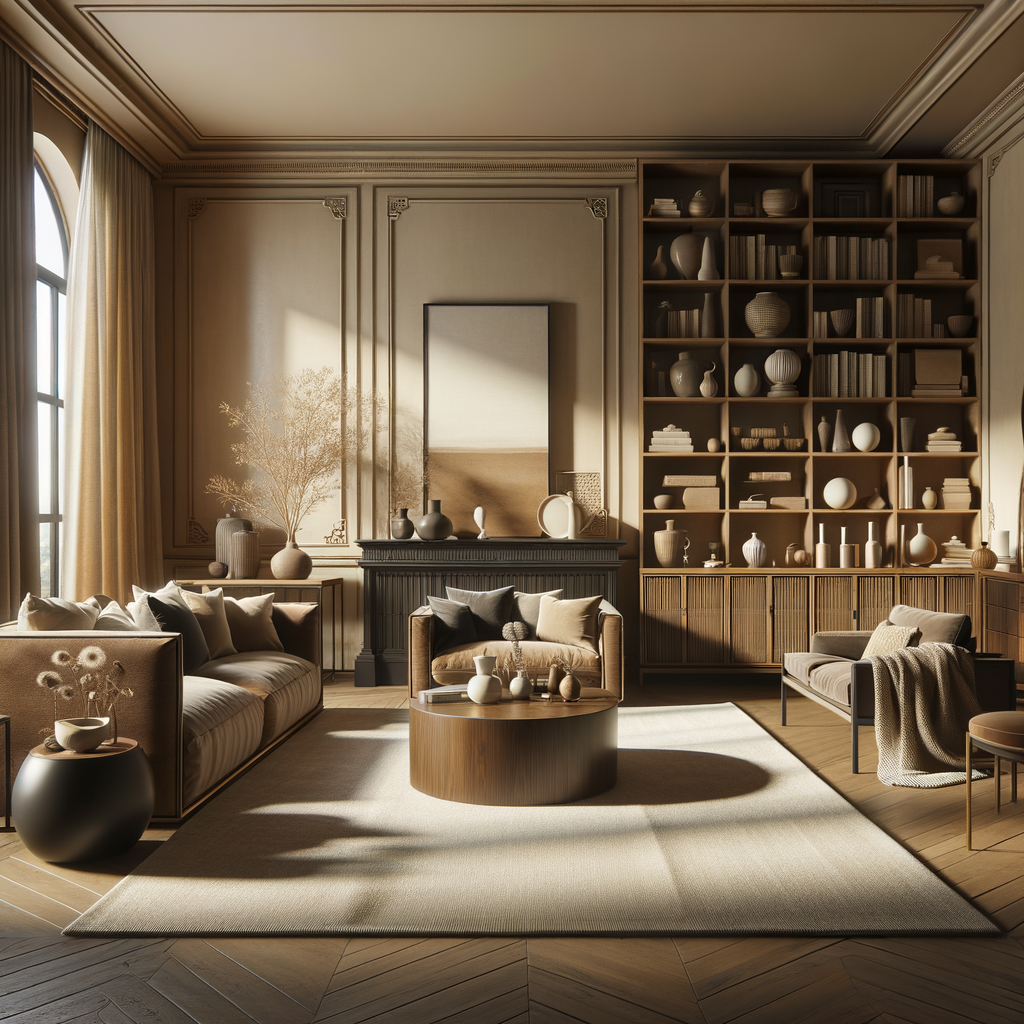
I highly recommend a light tan or beige wall color to beautifully complement dark brown furniture.
The light neutral tone creates a subtle and elegant contrast against the rich, deep brown hues.
Beige walls allow the exquisite details and wood grain of mahogany, walnut, or espresso-colored furniture to really stand out.
The light color opens up the space and keeps things feeling bright and airy.
Yet there is enough contrast with the brown to add some depth and dimension to the room.
I suggest sticking to soft, warm-leaning beiges rather than anything too gray or greige.
A light camel, biscuit, or almond beige will elegantly flatter the brown furniture.
The lightness helps the smaller details in the furniture like carvings, legs, and hardware pop.
Having this soft, neutral beige canvas allows you to add personality through accent pieces, artwork, throws, and more.
Feel free to play with different textures too – consider a cozy linen-look beige versus a flat, painted beige.
This color scheme is versatile enough to work in casual, transitional, traditional, or even modern spaces.
The beige walls bring a touch of sophistication that allows the gorgeous brown furniture to feel elevated.
I recommend this timeless wall color not only for living spaces but also bedrooms and studies where you want to create a peaceful, welcoming vibe.
Let the brown furniture take center stage against those light beige walls.
Cream
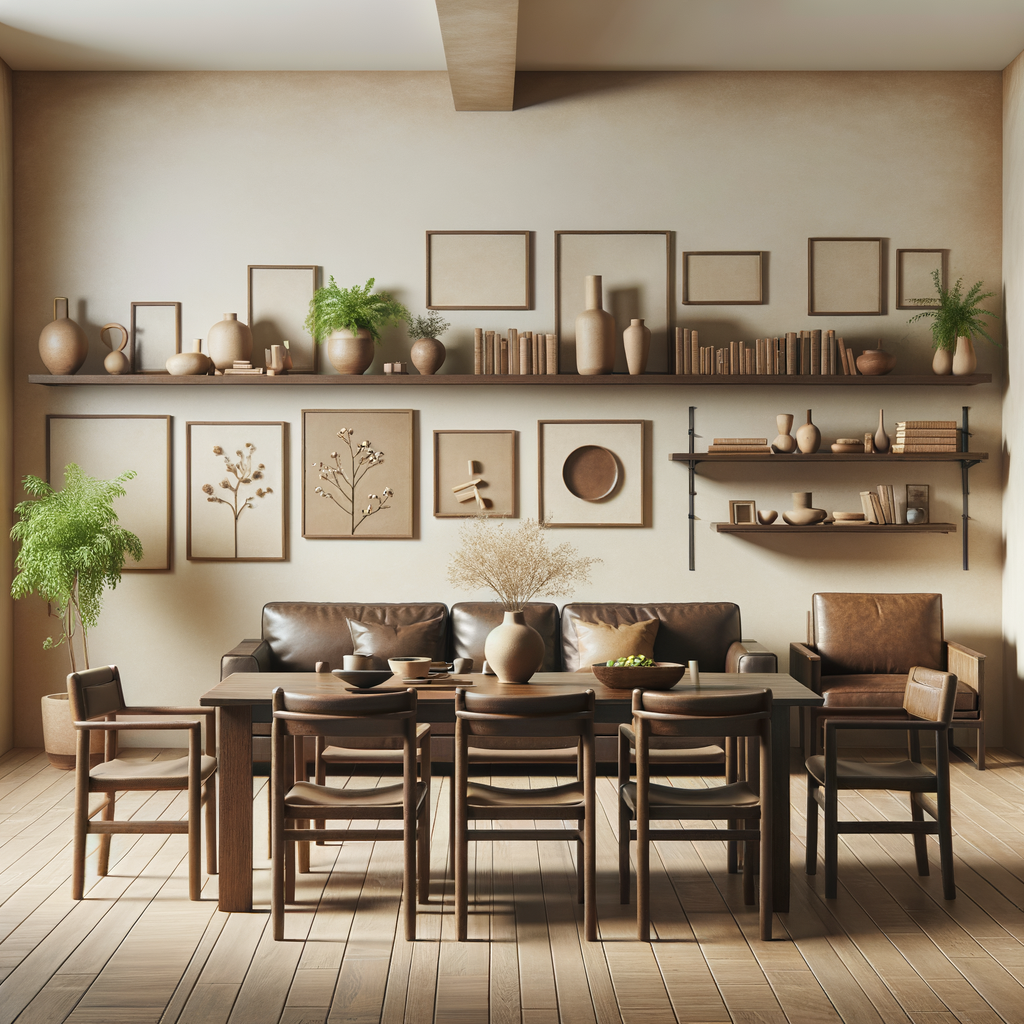
The soft, warm cream color perfectly complements and enhances the rich beauty of the dark wood.
Cream has a soothing, welcoming effect that offsets the dramatic look of dark brown.
It softens the overall aesthetic and makes the space feel more bright, airy and spacious.
At the same time, cream provides enough contrast to make all the gorgeous graining and wood details really stand out in the furniture.
I’d suggest using an organic shade like milk cream, rice cream or oatmeal cream.
Stay away from bright whites, which can feel too harsh.
The organic cream adds a subtle warmth that feels cozy yet still refined.
This combo works well in traditional living rooms where you want to play up the elegance of wood furnishings.
It’s also ideal for bedrooms for a relaxing, peaceful feel.
Accent with touches of light blue or sage green for some subtle color.
Cream walls allow you to highlight some beautiful dark brown furniture as the focal point.
Use accents like florals, textured pillows and ceramics in the same color scheme to tie it all together seamlessly.
The dark and light contrast will feel welcoming and timeless.
Whether you have an antique mahogany set or modern walnut pieces, the cream backdrop will let the textures and details shine through beautifully.
I highly encourage this classic, complementary color scheme for spaces where dark brown furniture takes center stage.
Soft White
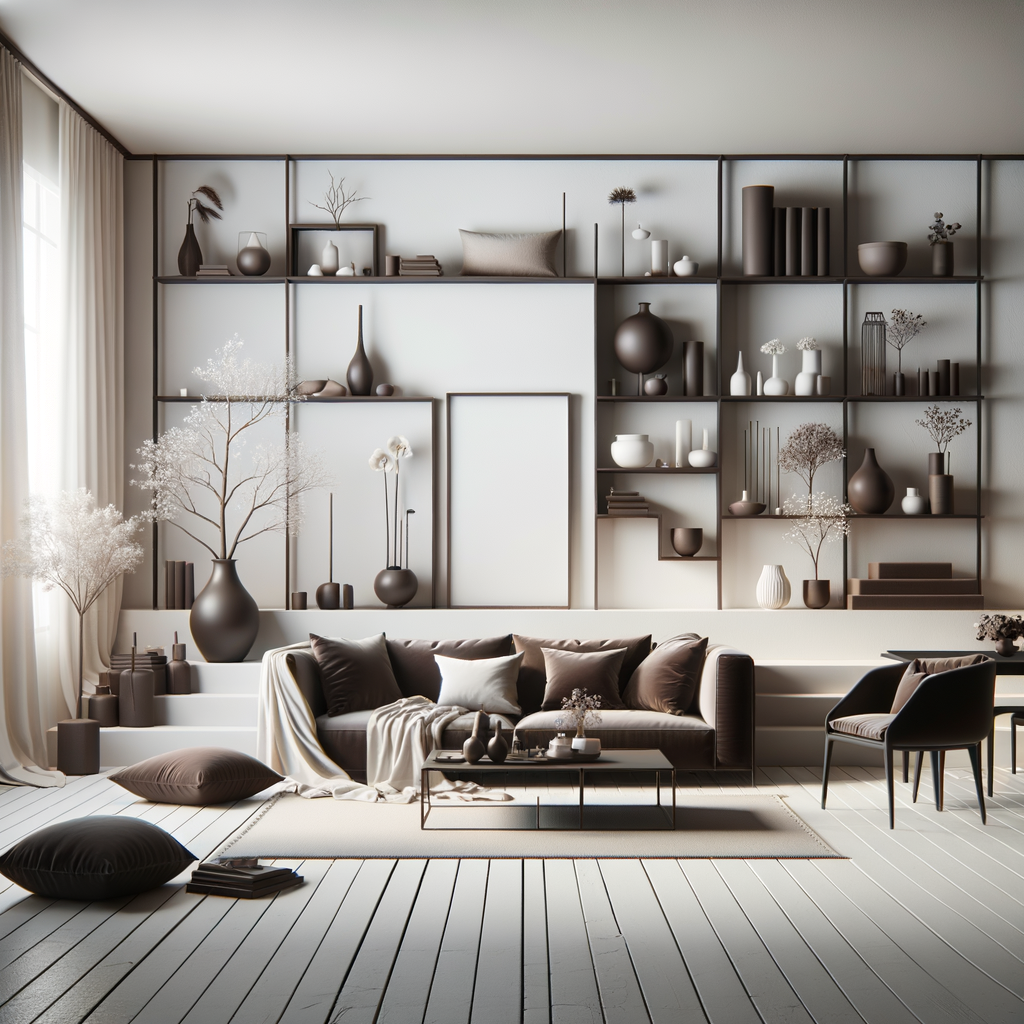
The clean, bright white provides the perfect neutral backdrop to really make the beautiful rich wood tones pop in the space.
Soft white has a warm, versatile quality that works well with the depth and sophistication of dark brown wood pieces.
It creates an open, airy feel in the room to offset the cozy boldness of the furniture.
The white walls also ensure the wood graining and any ornate details in the brown furniture will stand out.
I’d recommend a soft white with a hint of cream or tan rather than a stark bright white, which could feel sterile.
Soft white reflects light beautifully to make the room feel light and spacious while accentuating the dark wood tones.
This color scheme is one of my go-to recommendations for living rooms, dining rooms and bedrooms where the client wants to showcase gorgeous mahogany, walnut or espresso furniture.
The soft white walls keep the focus on the exquisite craftsmanship of the furniture as the star of the space.
Whether the aesthetic is modern, traditional or farmhouse, soft white walls are a timeless, elegant choice that complements and enhances dark brown furniture wonderfully.
I suggest adding soft tans, blues and greens as accents throughout for a polished, welcoming look.
The soft white background truly makes the brown wood pop.
Gray
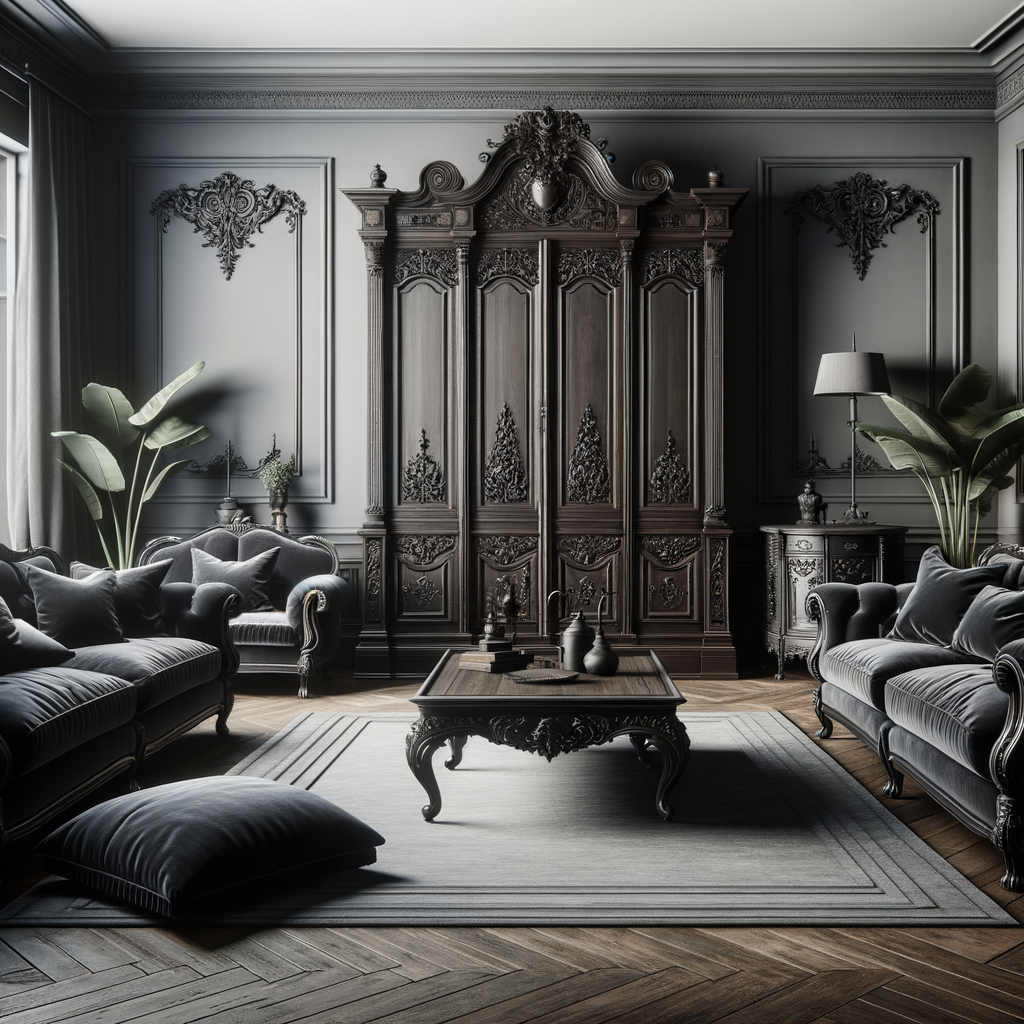
I often recommend different shades of gray as an elegant wall color pairing with dark brown furniture.
The muted, sophisticated grays beautifully complement the richness of the dark wood tones.
Light grays like fog, dove gray or silver gray add subtle contrast while still allowing the brown furniture to take center stage.
These soft, neutral grays open up the space and provide an airy, bright backdrop for the dramatic wood pieces.
For a more moody, cozy feel, look at greiges or medium taupes which have brown undertones that connect with the furniture.
I also love deep charcoal gray with dramatic dark brown mahogany or ebony – the bold contrast is striking and luxurious.
Cooler grays with blue undertones work well in modern or contemporary rooms, while warm grays better suit traditional spaces with brown furniture.
Always sample your grays as undertones can read differently on the walls.
Since gray is versatile, this color scheme can work in living rooms, bedrooms, offices and more.
Add metallic accents or sculptural lighting for a glam vibe.
Layer in natural elements like stone, cedar and sheepskin to create an earthy contrast with the gray and brown.
Overall, gray walls allow you to really appreciate and highlight the beauty of dark wood furniture.
The muted palette lets the gorgeous graining and wood details take center stage while creating a sophisticated, elegant feel in the space.
✨Click to Get My 101 FREE Designer Room Ideas
Light Blue

A light blue wall color can provide a gorgeous complementary backdrop for rich, dark brown furniture.
The soft blue tone creates an uplifting, airy feel that beautifully offsets the dramatic, bold look of dark wood pieces.
I’d recommend a baby blue, cloud blue or even a robin’s egg blue for a vintage vibe.
The light blue will add a crisp, peaceful ambience to a space furnished with dark mahogany, walnut or espresso.
It highlights and accentuates the warm wood tones in a clean, understated way.
The contrast between the two colors is striking yet subtle.
Light blue works particularly well in bedrooms furnished with dark wood beds, armoires and nightstands.
It creates a relaxing, restful retreat.
In living spaces, it provides energizing contrast and keeps things feeling bright and cheery.
Don’t be afraid to layer in some white trim, off-white furniture and warm wood accents like jute rugs to provide depth and connect the blue walls with the dark brown anchor pieces.
Add some brass or gold accents for a polished look.
Overall, light blue walls allow dark brown furniture to really stand out while creating a fresh, uplifting backdrop.
It’s a versatile, timeless color combination that provides the perfect balance of vibrancy and tranquility.
Sky Blue
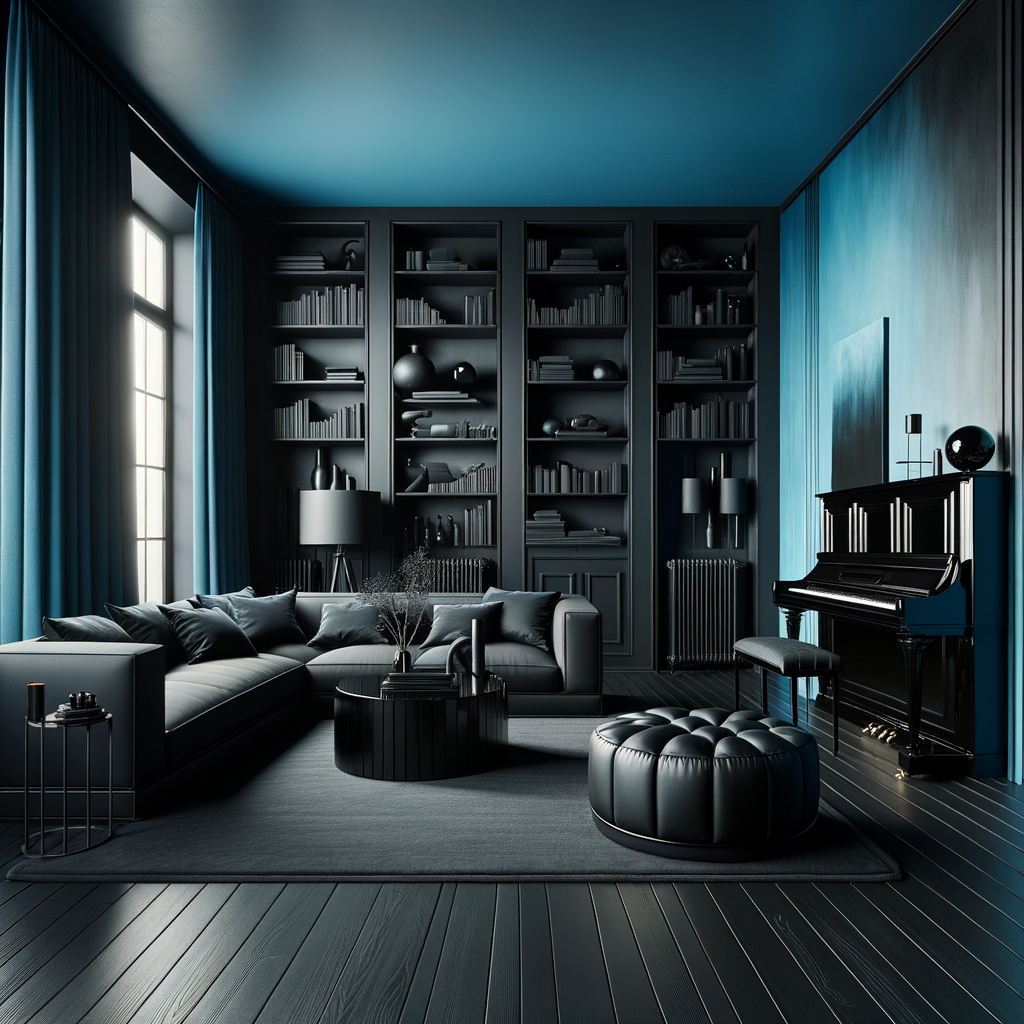
The vibrant, cheerful sky blue is a perfect complementary color that really makes the rich, warm wood tones pop.
A sky blue in a medium robin’s egg shade adds an energizing, uplifting feel that beautifully offsets the boldness of dark brown mahogany, walnut or chocolate-colored furniture.
It makes the wood graining and details shine.
This fun color combo is great for creating a youthful, cottage-chic living room.
The sky blue walls make the space feel bright and happy, while the dramatic wood anchors it with a traditional warmth.
Add in some white trim and you have a playful, inviting aesthetic.
Sky blue also works nicely as an accent wall in a bedroom with dark wood furnishings.
It adds softness and vibrancy.
Pair it with some bright white bedding and natural wood nightstands for a seamless look.
The color combination can also be adapted for eclectic, bohemian spaces by layering in some vintage rugs, colorful art, and whimsical accessories.
Keep the rest of the walls light and neutral.
Overall, the vibrant optimism of sky blue walls makes dark brown furniture really stand out.
It creates the perfect balanced, harmonious pairing.
The result is a stylish, inviting room with timeless appeal.
Pale Yellow

A pale yellow can create a warm, sunny backdrop that beautifully complements and enhances dark brown furniture.
I’d recommend soft shades like lemon chiffon, cream yellow or daffodil to provide a cozy, welcoming glow.
The pale yellow adds just enough vibrancy to offset the bold richness of dark mahogany or walnut wood tones.
It feels fresh and brightens up the space while still allowing the brown furniture to anchor the room with traditional sophistication.
This color scheme is perfect for creating an inviting living room, bedroom or dining space.
The pale yellow walls exude warmth and feel cheery when combined with dramatic dark wood pieces.
Just take care not to choose too bright or neon yellow, which could overwhelm the space.
To tie the palette together, I’d layer in some creamy off-white upholstery, natural elements like jute rugs and rattan accents, and even pale blue and sage green tones.
Brushed gold or antique brass lighting and hardware also beautifully bridge the gap between pale yellow walls and dark brown furniture.
Overall, the right soft, sunny pale yellow can make dark brown furniture pop while feeling cozy and welcoming.
It’s a classic combination that works well in many design aesthetics from traditional to rustic farmhouse style.
Light Peach

The soft peach tones add a subtle vibrancy while still allowing the rich beauty of the wood to shine.
A light peach like nectar or melon provides just the right amount of color without overwhelming the space.
It feels fresh yet understated, and adds a romantic, feminine energy that works beautifully with dramatic mahogany or deep espresso furniture.
The peach walls bring out the reddish undertones in the brown wood pieces, connecting the two in a harmonious way.
At the same time, the light peach keeps things airy and spacious feeling rather than too heavy or rustic.
This color pairing is ideal for bedrooms, living rooms and sitting areas where you want to create a relaxed yet polished feel.
Accent with creams, light blues and metallic for a complete look.
Consider peachy pinks too for a touch more vibrancy.
Light peach walls let the details of gorgeous wood grains and carvings take center stage, while providing the perfect warm, nuanced backdrop.
The dark brown anchors the peach so the palette doesn’t become too sweet or saccharine.
Overall, it’s a romantic, charming color combination that plays up the beauty of dark furniture in an inviting way.
The light peach brings out the best in the brown wood tones.
✨Click to Get My 101 FREE Designer Room Ideas
Sage Green
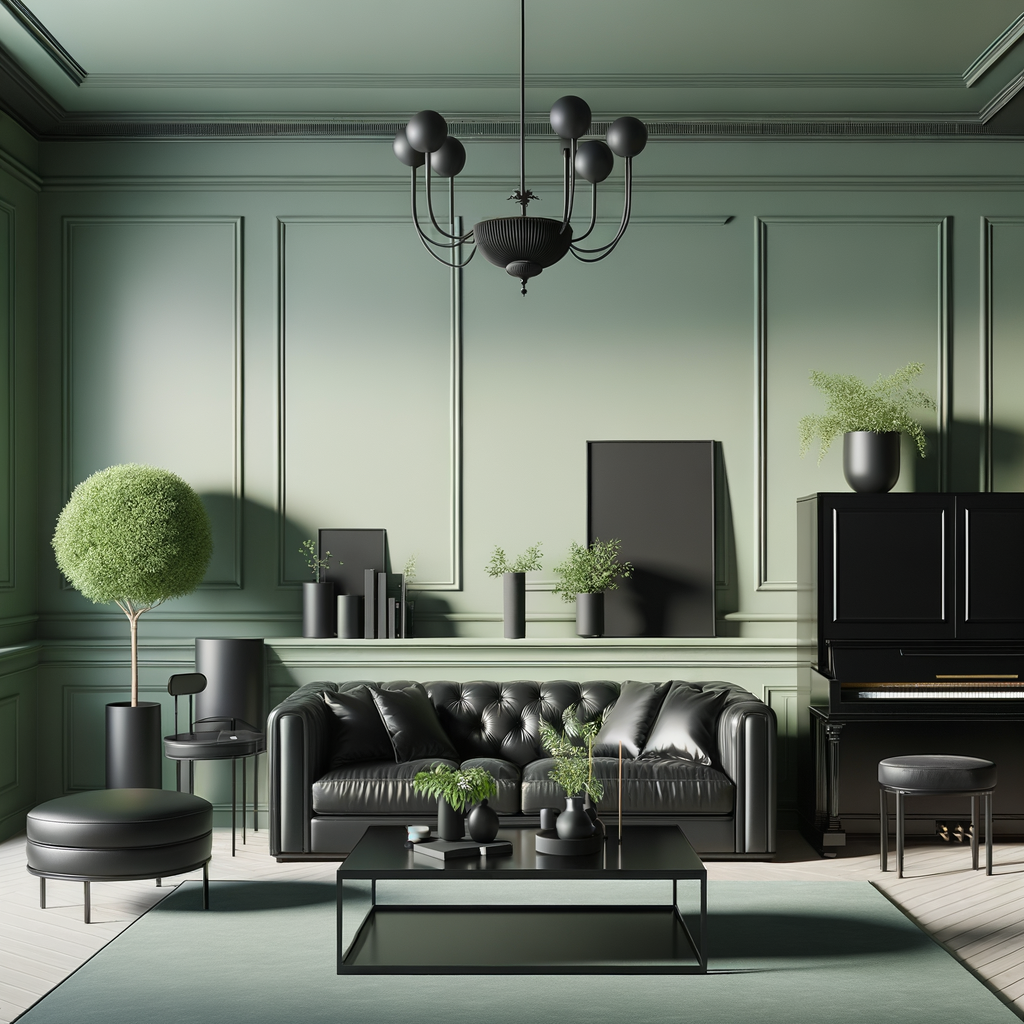
A soft, earthy sage green can create a beautiful, tranquil ambience that perfectly complements rich, dark brown furniture.
It feels natural, organic and relaxed.
I’d recommend a muted tone like jade, seafoam or mineral green.
The subtle vibrancy pairs elegantly with the boldness of dark mahogany, walnut and espresso wood pieces.
It’s an understated, harmonious color combination.
Sage green has grayish-blue undertones that connect with the cool tones in brown furniture, while contrasting nicely against the warmth of the wood.
It feels both brightening and moody in an elegant way.
This color scheme does well in transitional living spaces, bedrooms and studies where you want a calm, inviting atmosphere.
Layer in elements like stone, wood accents and natural fiber rugs to complement both colors.
Metallic touches also pair nicely.
Overall, sage green walls really make the wood grains and rich details of dark brown furniture pop while creating a sophisticated, earthy feel.
It’s a timeless, versatile color combination that works well in many styles from modern farmhouse to traditional.
Peaceful and elegant!
Celadon Green
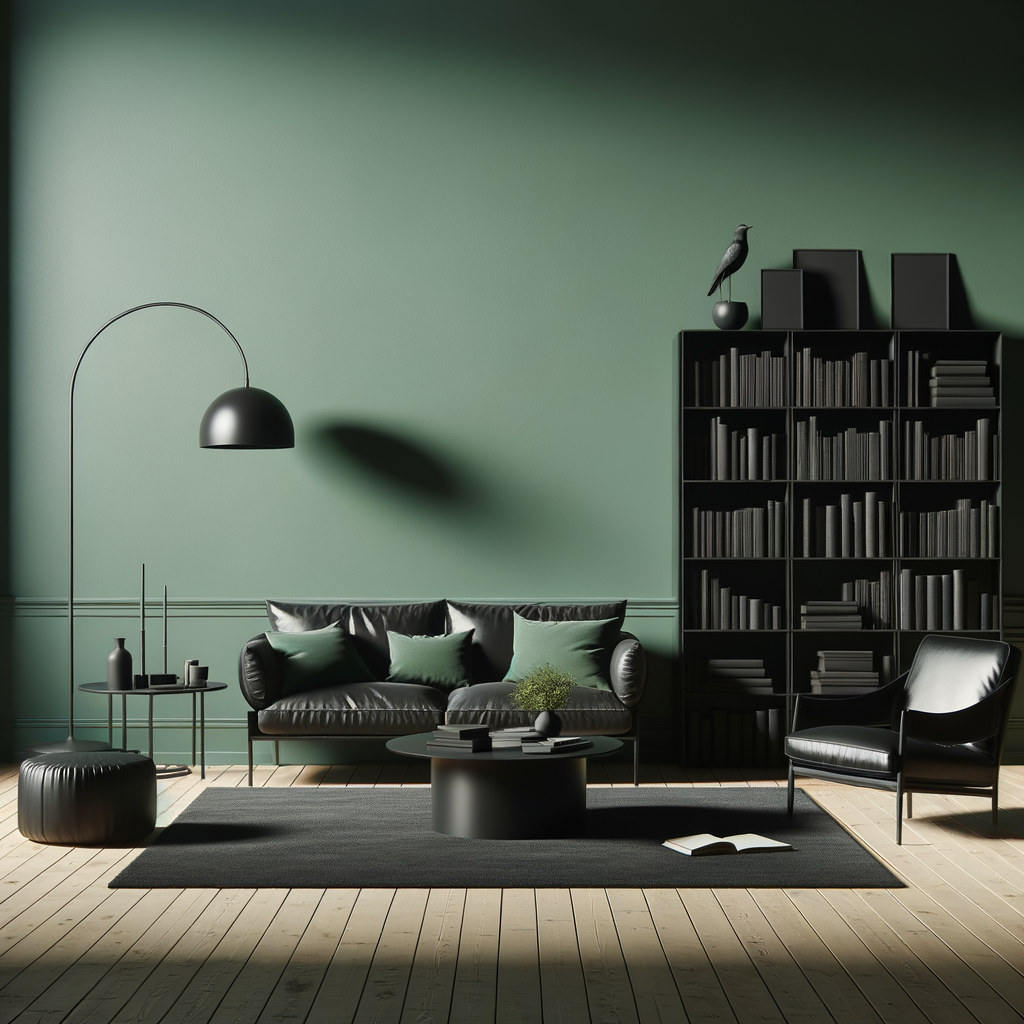
Celadon green is a pale, muted green with grayish-blue undertones that can pair beautifully with rich, dark brown furniture.
It provides a soft, tranquil contrast to bold mahogany and espresso wood tones.
I recommend a very light celadon, almost a minty sage.
This pale green has enough subtle vibrancy to keep a room from feeling too heavy or rustic, but still complements the dramatic wood furniture in an understated way.
The cool celadon green brings out the blue undertones in the brown.
It feels relaxing and zen, perfect for bedrooms with dark wood furnishings.
For living areas, it adds a unique pop of color without overwhelming.
To tie the celadon walls together with dark brown furniture, add in cream upholstery and wool rugs as well as natural wood accents.
Brass hardware also bridges the gap nicely between the two colors.
Overall, celadon green creates a calm, inviting backdrop for making dark wood furniture pop.
It feels fresh while still harmonious and grounded.
The pale vibrancy offsets the boldness of the brown in a unique but complementary way.
Robin’s Egg Blue
This color combination works particularly well in smaller spaces like studies, sitting rooms or dining nooks.
The saturated blue makes these intimate spaces feel vibrant yet cozy when anchored with dark wood pieces.
For larger living rooms, use Robin’s Egg blue sparingly such as on one accent wall.
Pair it with plenty of crisp white on the other walls to keep the space feeling open and airy.
Robin’s Egg blue can feel quite playful and youthful.
It works well in kids’ rooms or teen bedrooms paired with dark mahogany bunk beds, desks or bookshelves to ground the space.
Don’t be afraid to carry the blue tone throughout the space with accents.
Blue and white throw pillows, area rugs with blue patterns, and blue decorative objects help tie it all together.
Cooler blues like Robin’s Egg work nicely with brown furniture that has more reddish-purple undertones.
If the brown has yellow/orange undertones, try a warmer blue instead.
For a more sophisticated look, glossy or metallic blue accents help elevate the pairing.
Think glossy lacquered nightstands or a brushed brass light fixture.
Overall, Robin’s Egg blue as a wall color makes a bold, lively statement that allows rich dark brown furniture to feel stylish and striking.
Use it wisely to create a dazzling, memorable space.
Buttercream
Buttercream is a warm, mellow yellow shade that can create a beautiful complementary pairing with rich dark brown furniture.
It provides a cozy, welcoming contrast.
I’d recommend a soft buttery yellow, almost like a pale daffodil or lemon custard.
This muted tone keeps the room feeling bright yet relaxed.
It offsets the boldness of dark mahogany or walnut without competing.
The buttercream walls make the wood graining and caramel undertones of the brown furniture pop.
It feels cheerful and sunny without overwhelming the space when combined with dramatic wood pieces.
This color pairing is wonderful for living rooms, bedrooms and dining spaces where you want to create an inviting, cozy feel.
Layer in elements like sheer white linens, cream rugs and brass accents to tie it all together seamlessly.
Buttercream walls allow the exquisite craftsmanship of the dark wood furniture to take center stage, while feeling warm and welcoming.
It provides the perfect balance of understated vibrancy.
Overall, buttercream makes for a harmonious, timeless color combination with dark brown furniture.
It feels fresh and bright while still complementing the sophistication and depth of the wood tones beautifully.
✨Click to Get My 101 FREE Designer Room Ideas
Lavender
A soft, muted lavender can create an elegant pairing with rich dark brown furniture.
The subtle cool tones of lavender complement the warmth of the wood beautifully.
I’d recommend a lighter dried lavender or lilac shade.
These muted purples add just enough color without overwhelming a space dominated by bold mahogany or espresso furniture.
Lavender has a romantic, feminine quality that softens the traditional masculinity of dark wood pieces.
It provides enough contrast to keep a room from feeling too heavy or rustic.
This color combination works well in bedrooms, living rooms, and offices where you want to create a relaxed yet refined feel.
Accent with creams, light blues and metallic for balance.
The lavender walls allow the exquisite details of the wood furniture to take center stage while providing a sophisticated, artful backdrop.
It’s an unexpected color pairing with timeless appeal.
Overall, a soft muted lavender hue can make dark brown furniture feel elevated and striking without overpowering the beauty of the wood.
It’s a versatile, artistic color choice for various rooms and design aesthetics.
Light Rose Pink
A soft, delicate light rose pink can create a gorgeous feminine complement to rich, dark brown furniture.
The color combination feels romantic and charming.
I’d recommend a muted tone like blush, rose quartz or petal pink.
These subtle shades offset the boldness of dark mahogany or walnut in an elegant way.
The pink provides just enough contrast without overwhelming.
Light rose pink has a welcoming, uplifting effect that keeps a space from feeling too heavy or rustic.
It brings out the warm reddish undertones in the brown wood tones beautifully.
This color pairing works wonderfully in bedrooms, living rooms, studies and sitting areas where you want a relaxed yet put-together feel.
Accent with metallic, white linens and florals.
The light pink walls allow the wood grains and details of the furniture to truly shine while providing a soft, feminine backdrop.
It creates a seamless, harmonious look.
Overall, light rose pink is a graceful, nuanced color that makes dark brown furniture pop.
It feels romantic, bright and timeless – an elegant match for traditional rich wood pieces.
Olive Green
A muted olive green can pair beautifully with rich, dark brown furniture.
The earthy green tone complements the warmth of the wood while providing subtle vibrancy.
I’d recommend a gray-tinged sage green or muted khaki olive shade.
This will prevent the green from feeling too bold or intense against the dramatic brown wood.
Olive green has natural, organic undertones that connect well with the graining and caramel hues of mahogany, walnut and teak furniture.
It feels grounded and harmonious.
This versatile color combination works in many styles from modern farmhouse to industrial.
Olive green can translate from relaxed family rooms to refined studies gracefully.
To make the palette cohesive, incorporate elements like jute rugs, linen upholstery, wood accents and brass lighting.
Cream walls provide balance.
Overall, olive green walls allow you to appreciate the beauty of dark wood furniture while providing an earthy, subtle backdrop.
It’s a flexible, relaxed color pair that stands the test of time.
Burgundy
A rich, jewel-toned burgundy can create a striking, elegant pairing with dark brown furniture.
The deep reddish-purple tone complements and enhances the dramatic wood beautifully.
I’d recommend a burgundy with red-violet undertones rather than one that leans too brown.
This provides enough contrast and vibrancy against dark mahogany or walnut wood.
Burgundy has an air of sophistication and luxury that emphasizes the opulence of finely crafted brown furniture.
It feels bold yet refined, perfect for formal living rooms and dining spaces.
This powerful color combination works well when you want the furniture to be the main focus.
Keep burgundy walls in the background and let the gorgeous wood grains take center stage.
To prevent it from feeling too dark and heavy, balance it with creams and metallic.
Gilt-framed artwork and mirrored accents also help brighten the space.
Overall, a rich burgundy wall color allows you to appreciate the artistry of dark brown furniture while creating a glamorous, elegant ambience.
It’s a striking, upscale color combination.
✨Click to Get My 101 FREE Designer Room Ideas
Navy Blue
Navy blue creates a dramatic, moody contrast against rich dark brown furniture.
The deep blue tone emphasizes the warmth of the wood while feeling bold and sophisticated.
I’d recommend a navy with some gray undertones rather than a brighter royal blue, which could overwhelm the brown.
A muted navy is impactful but versatile.
This color pairing is ideal for living rooms, dining rooms, studies and bedrooms where you want to create an elegant, enveloping atmosphere.
The navy showcases the beauty of the wood.
Add in cream upholstery and light blue accents to keep the space from feeling too dark.
Brass lighting and hardware also complement both the navy and brown tones nicely.
Navy walls allow you to use brown furniture in a more modern, bold way while still feeling classic and grounded.
It’s a timeless, stylish color combination.
In smaller spaces like bedrooms, use navy sparingly on one accent wall to frame dark wood headboards and nightstands with drama.
Keep other walls light.
Overall, navy blue walls provide the perfect moody, sophisticated backdrop to really make dark brown furniture pop.
The colors balance each other beautifully while feeling luxe and elegant.
Teal
A vibrant teal can create an energizing, striking pairing with rich dark brown furniture.
It provides just the right amount of contrast without overwhelming the wood tones.
I’d recommend a mid-tone teal with touches of green rather than a brighter blue teal.
This keeps things feeling a bit more relaxed and natural against the bold wood pieces.
The cool tones of teal bring out the subtle grays and blues in the brown wood grain.
It feels very complementary while still bold.
Teal adds a fun, casual vibe that can help balance out the traditional formality of mahogany or walnut furniture.
It’s great for keeping spaces feeling youthful.
For a beachy look, use teal walls in a living room with dark rattan and driftwood accents.
Add in sand tones, woven textures and touches of coral.
In bedrooms, use teal on one accent wall to frame a dark wood bed.
Keep other walls and bedding light and airy.
Overall, the vibrant punch of teal walls allows you to appreciate the beauty of dark brown furniture in a fresh, lively way.
It’s a playful, energetic color combination
Pumpkin Orange
A rich pumpkin or burnt orange can create a warm, striking contrast against dark brown furniture.
The saturated hue complements the wood tones beautifully.
Stick to muted, earthy pumpkin shades rather than neon orange to keep the look grounded.
The bold orange is best used sparingly or on accent walls.
Orange has enough vibrancy to stand up to the dramatic presence of dark mahogany and walnut pieces without overwhelming.
It feels cozy and inviting.
This color scheme is perfect for rustic, bohemian, or Southwest style rooms.
Layer in elements like wood beams, terra cotta pots, jute rugs and leather.
For a sleeker look, balance the pumpkin walls with clean lines, cream upholstery and modern metallic.
This keeps things feeling polished and elegant.
In small doses like on shelving or recessed book nooks, pumpkin orange can add a fun splash of color to highlight brown furniture.
Overall, pumpkin orange walls bring out the warmth and richness of dark wood pieces in an energizing, complementary way.
The bold contrast really makes both colors shine beautifully.
Forest Green
A deep, earthy forest green can create a striking and sophisticated pairing with rich, dark brown furniture.
The dark green has enough bold vibrancy to stand up to dramatic mahogany and espresso wood pieces without overwhelming them.
Forest green complements the reddish undertones in the brown furniture, while the wood balances out the intensity of the green.
This allows both elements to shine.
Together, the colors create an enveloping, luxe feel that works well in formal living rooms, studies, and dining spaces.
It’s elegant but still organic.
Accentuate the look with elements like leather upholstery, dark wood accents, and brass details.
Cream tones and natural light balance it out.
In smaller spaces like bedrooms, use forest green sparingly on an accent wall to frame dark wood headboards, beds and dressers with drama.
The colors evoke a traditional English countryside manor.
Lean into this with classic detailing and wood-carved furnishings.
Overall, a moody forest green makes for a sophisticated, opulent pairing with dark brown furniture.
The colors complement each other beautifully while feeling bold, refined and timeless.
Terracotta
A warm terracotta or burnt orange hue can create a striking yet earthy combination with rich dark brown furniture.
The reddish-orange tone of terracotta beautifully complements and brings out the wood’s natural warmth and graining.
It feels organic.
I’d recommend a muted, rustic terracotta that has more subtle gray undertones.
This prevents it from feeling too overwhelming or bright against dark woods.
Terracotta adds a casual, inviting vibe that keeps formal dark mahogany or walnut pieces from feeling stuffy.
It’s great for family spaces.
Lean into the earthy charm of this pairing by adding elements like jute rugs, woven textures, reclaimed wood accents and black iron metals.
For bedrooms, use terracotta sparingly on one accent wall as a headboard backdrop to allow the wood furnishings to shine.
Overall, terracotta creates a grounded, welcoming pairing with dark brown furniture.
The colors complement each other beautifully in a natural, organic way.
In conclusion, the wall color you choose can have a big impact on highlighting or balancing dark brown furniture.
Whether you prefer airy neutrals like light peach or sage green, striking vibrancy like navy blue or teal, or earthy tones like terracotta or olive, the options are diverse.
Focus on choosing colors with undertones that complement the specific brown wood tones in your space.
Cool grays and blues suit furniture with purple undertones, while warm peaches and yellows suit orange-tinged wood.
Also consider the mood you want to create – light, airy colors like buttery yellows or soft pinks keep things relaxed and feminine, while bold hues like forest green or burgundy create drama.
And don’t forget to incorporate accent colors throughout with upholstery, area rugs and accessories to tie your palette together.
This allows the beauty of your dark wood furniture to take center stage, framed by colorful walls that enhance and balance the rich tones beautifully.

